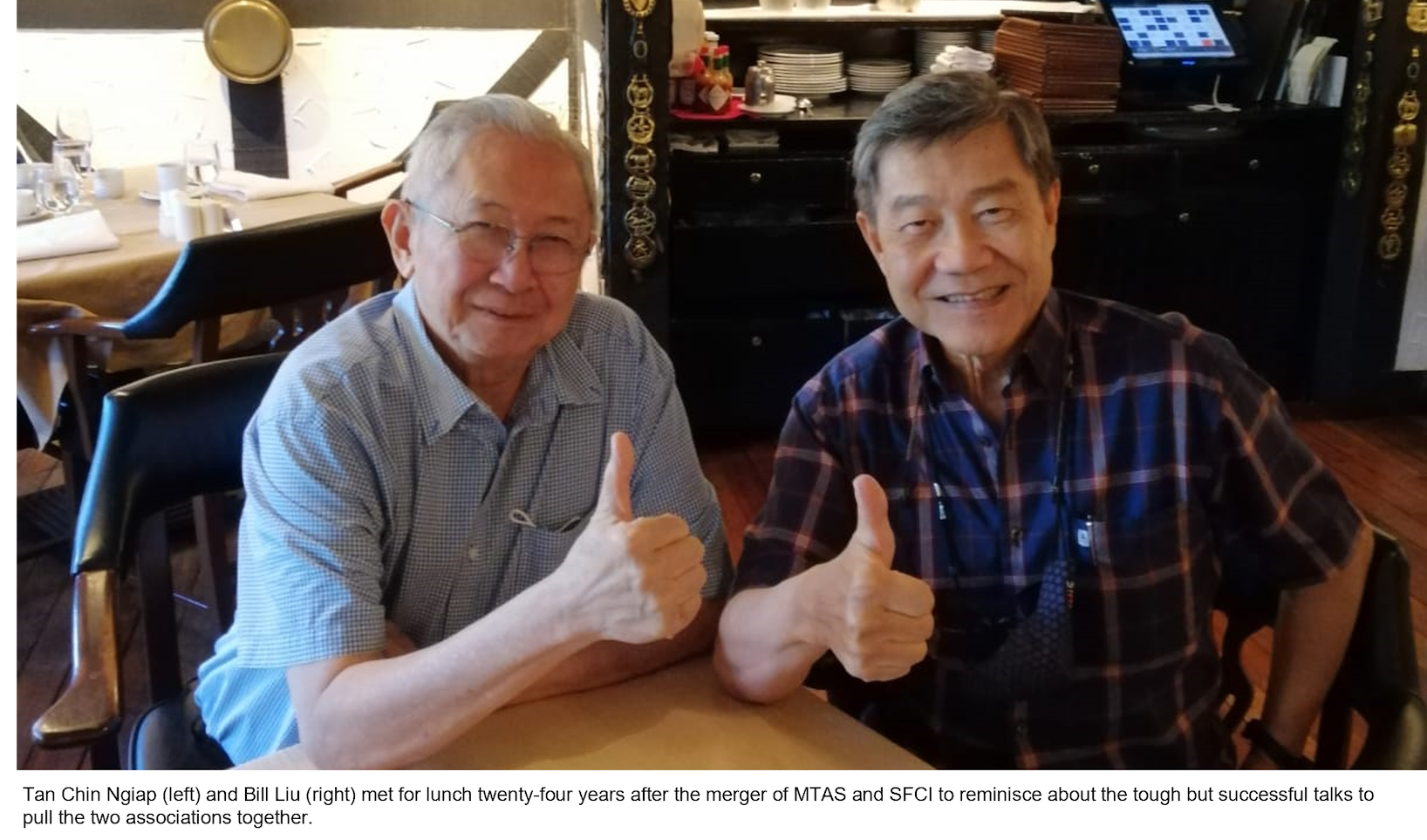Merging Two IT Groups into One Unified Association for Stronger Representation of the Tech Industry
Tan Chin Ngiap (left) and Bill Liu (right) met for lunch twenty four years after the merger of MTAS and SFCI to reminisce about the tough but successful talks to pull the two associations together
The Singapore Federation of the Computer Industry (SFCI) was founded in 1982 by multinational computer companies like IBM, ICL, NCR and Sperry Univac while the Microcomputer Trade Association (MTAS) which represented the smaller local companies in the microcomputer/PC trade. MTAS members included companies such as Primefield, Creative Technology, SIS Technology IPC, Aztech and Sistek.
The objectives of the two associations were very different, each catering to a separate set of members with their own objectives and interests. SFCI was the national organisation in Singapore, leading and representing the IT industry and partnering with relevant government and international bodies.
MTAS set out to promote the interests and support its members in scaling the microcomputer sector. In 1981, IBM had launched the PC, revolutionising the computing industry. By the mid-1980s, original equipment manufacturers (OEMs) in Singapore like IPC and Aztech had emerged. They were selling their own PC brands to the local market and overseas. MTAS worked hard to enhance the professional standards among its members.
At the Government level, the then National Computer Board (NCB) was set up in 1981 to promote digitalisation and develop the infocomm industry. It was keen for the two associations to merge and form a single body so as to unite an increasingly fragmented industry. A merger would also enable the NCB to just deal with one entity for industry feedback and governance.
In 1998, I was the Chairman of Singapore Federation of Computer Industry (SFCI), as SGTech was known at that time. With the support of SFCI Council, I reached out to my MTAS counterpart, Tan Chin Ngiap, to begin the merger courtship.
Fortunately, I knew Chin Ngiap’s brothers. Tan Chin Nam was the first general manager of NCB; Tan Chin Tiong was an old boy of my alma mater Catholic High School and Tan Kok Kheng, entrepreneur and founder of Everbloom Mushroom, was my National Service buddy. This helped to break the ice when we began discussions.
The merger talks were a fairly protracted affair, serious but friendly. taking nearly a year to complete, as it involved not only the two councils but also their respective members.
While the overall synergies of the merger and the ability to speak with one powerful voice for the entire industry were generally recognised, both organisations had to work through major issues.
On SFCI's side, some members were concerned over the professional standing of the enlarged association and how the merger of the two very distinct entities would affect the overall governance of the members and their code of conduct.
On the MTAS front, the fear of being overshadowed by their bigger and more powerful “relatives”, that is, the MNCs, was foremost on their minds.
Another thorny issue was that the SFCI membership fee of S$2000 was considered too high for MTAS members, who were mainly small companies. Many were traders from Funan Centre paying around S$275 per year for their MTAS membership.
Of concern too was how to ensure that MTAS members were adequately represented on the Council of the merged entity so that the interests of its members could be safeguarded.
In our pursuit of a win-win outcome and with the image of being the Big Brother, SFCI was conscious that it did not come across as arrogant or high handed and that our future family members did not view SFCI as uncompromising and lacking in empathy.
During the negotiation talks, there was much to-ing and fro-ing. There were suggestions and counter-suggestions, and each organisation consulted their members several times.
Towards the end of the talks, there was a heart-stopping moment when an impasse cropped up. Some MTAS councillors were unhappy with the terms of the agreement. Discussions were halted and a cooling off period was called for to allow each side to reflect on the needs of each party. After about four weeks, better sense prevailed and discussions resumed.
 A give-and-take mindset allowed MTAS and SFCI to cross all hurdles for the merger to take place
A give-and-take mindset allowed MTAS and SFCI to cross all hurdles for the merger to take place
 A give-and-take mindset allowed MTAS and SFCI to cross all hurdles for the merger to take place
A give-and-take mindset allowed MTAS and SFCI to cross all hurdles for the merger to take place
 A give-and-take mindset allowed MTAS and SFCI to cross all hurdles for the merger to take place
A give-and-take mindset allowed MTAS and SFCI to cross all hurdles for the merger to take place

Tell us about your thoughtsWrite message